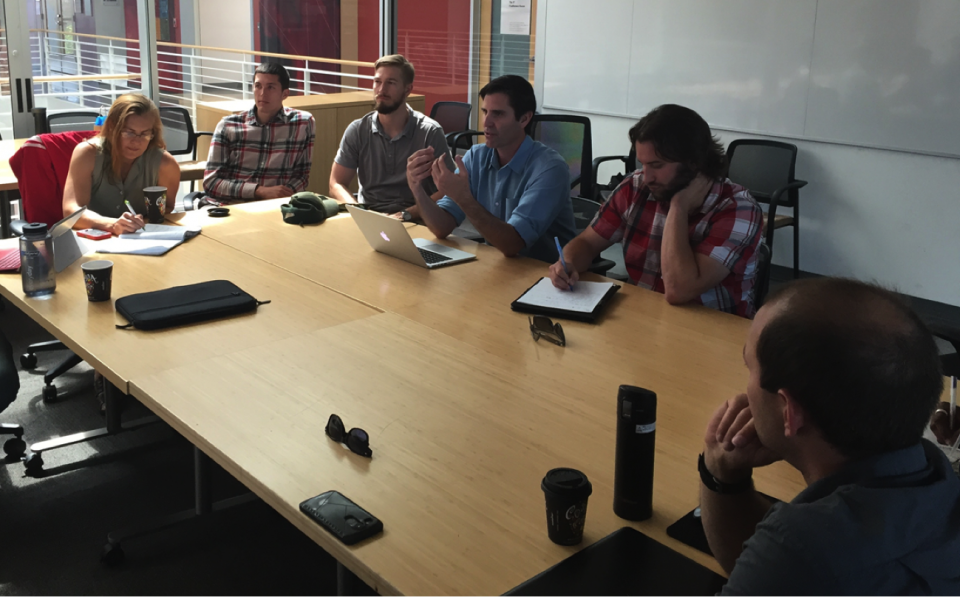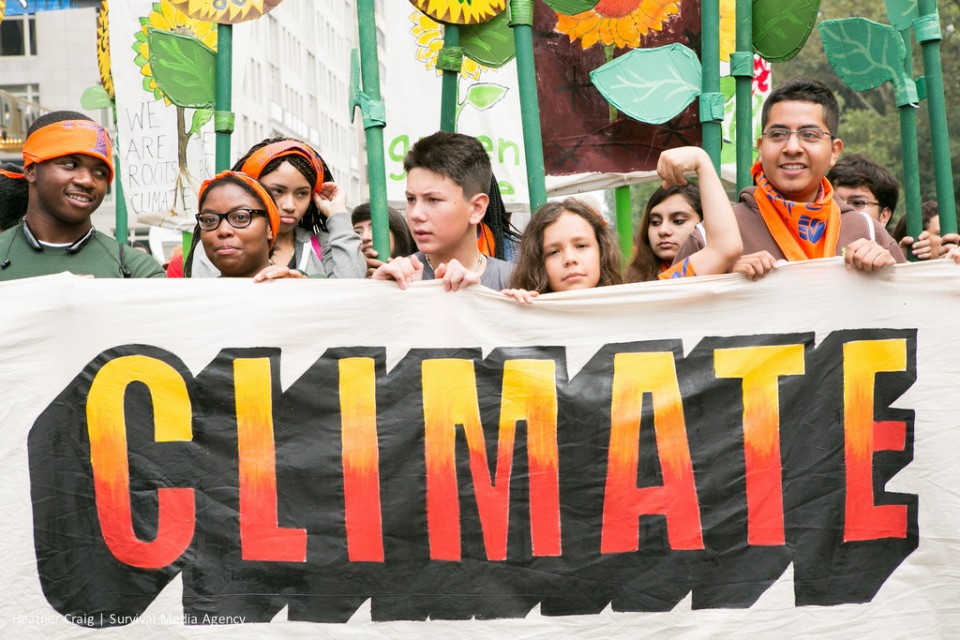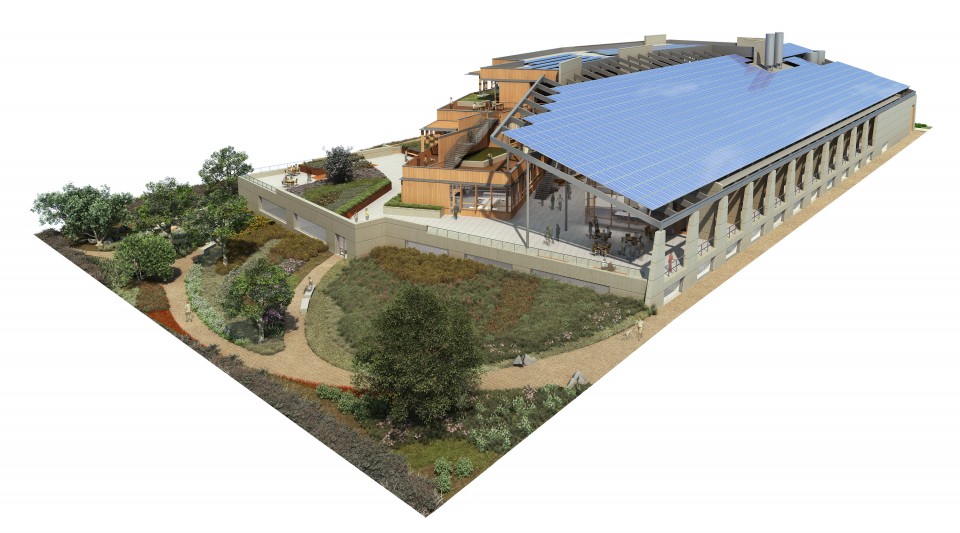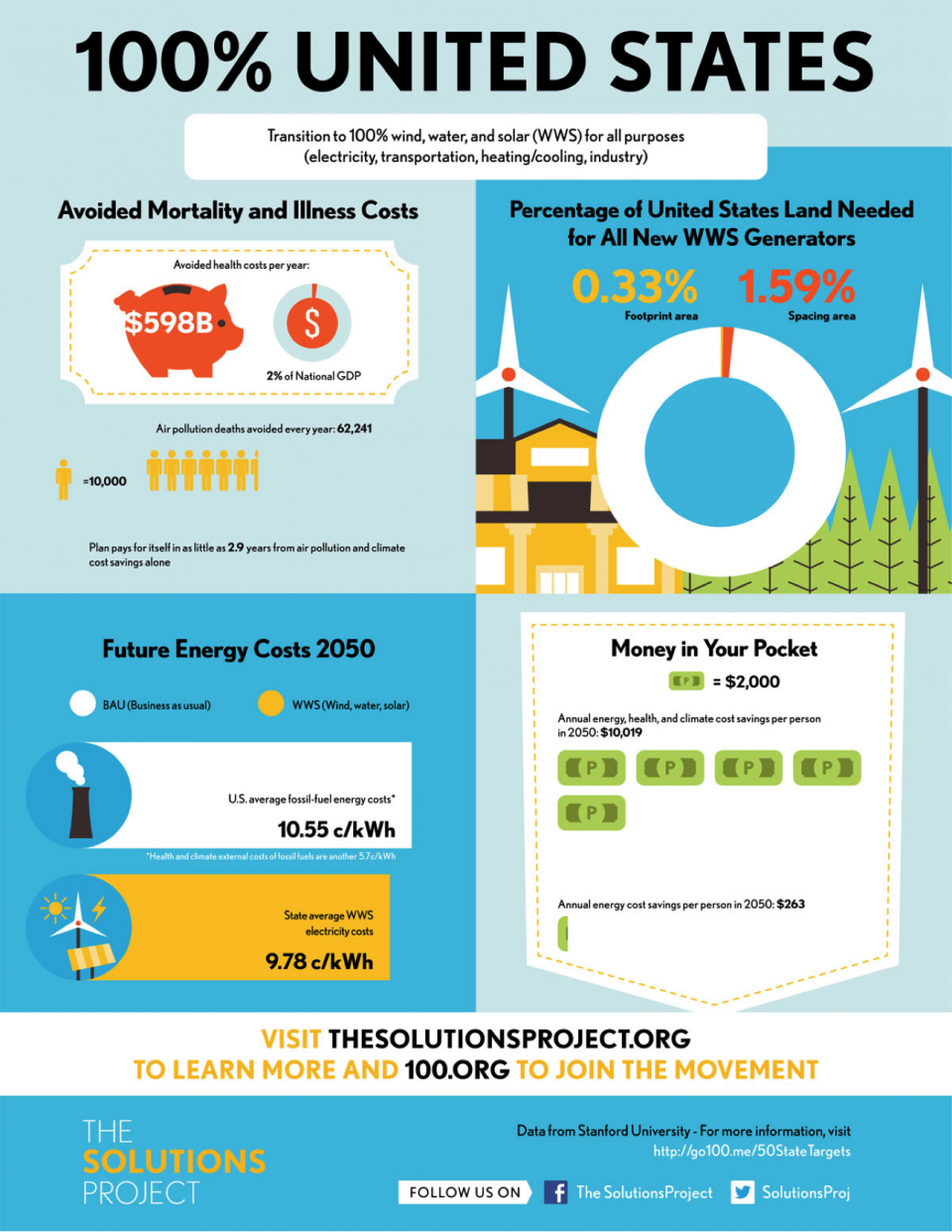100% Renewables
A 100% Renewable Future isn’t just about Climate
On 18, Oct 2016 | In PEI Blog | By Ethan
By Ethan Heil

The Point Energy team meets with Professor Mark Jacobson at Stanford University. From left to right, Alexis Karolides, Ethan Heil, Jordan Pratt (intern), Mark Jacobson, Derek Felschow and Chris Light.
Renewable energy could save over 5 million lives each year.
That’s the takeaway from a recent meeting among Stanford University Professor, Mark Jacobson and the Point Energy Innovations team.
Jacobson, notably, has led a research effort detailing how 139 countries – representing 95% of all carbon emissions, worldwide – could transition to 100% renewable energy by 2050. His research provides a way forward in light of growing international concern over a changing climate and the recent signing of the Paris Agreement – a historic commitment among 195 countries agreeing to limit greenhouse gas emissions and reduce global warming. The keystone component for meeting these ambitious emissions reductions requires a shift away from conventional, carbon-intensive energy sources based on coal, oil and natural gas combustion.
The climate benefits of carbon-free, renewable energy have been well-documented, but Jacobson suggests that the human health benefits are just as great, if not greater than, the far-reaching environmental benefits. The combustion of fossil fuels to power our cars, homes and offices releases particles and pollutants into the atmosphere. These emissions in turn contribute to 5.5 million premature air pollution deaths annually at a cost of $15-25 trillion each year (in addition to the costs associated with climate change).
Recognizing that buildings account for one third of our planet’s energy consumption, Jacobson and the Point Energy team discussed the crucial role of net zero energy buildings in enabling a cleaner, healthier and more renewable future. Net zero energy buildings produce at least as much energy as they consume. Green design practices in conjunction with on-site renewable energy provide an opportunity to convert buildings from a climate liability into a renewable asset. Jacobson’s own house provides a prime example of this opportunity. Pairing energy-efficient design techniques with a rooftop photovoltaic (PV) solar array allows his newly-constructed home to produce more energy than it consumes – and still have enough left over to charge his electric car. Point Energy Innovations applies similar principles on a larger scale, promoting cost-effective, environmentally sustainable approaches to reduce building energy consumption and integrate on-site renewable generation.
While many of us at Point Energy are familiar with the benefits of renewable energy from a climate and environmental sustainability perspective, our discussions with Jacobson highlighted the inextricable link between energy and human health. With this in mind, the Point Energy team will continue working towards a paradigm shift within the built environment from energy negative to energy positive by promoting the development of innovative, efficient and net zero energy buildings.
The Beginner’s Mind
On 08, Jan 2015 | In PEI Blog | By Peter
By Peter Rumsey

Citizens from 162 countries around the world participated in the People’s Climate March on September 21, 2014 marking it the largest demonstration on climate change in history.
Photo: Heather Craig, Survival Media Agency (Creative Commons)
“In the beginner’s mind there are many possibilities, but in the expert’s there are few.”
– Zen Master Shunryo Suzuki, Zen Mind, Beginner’s Mind
Some were taken by surprise when 300,000 or more people in New York City, and thousands more across the country and around the world, came out for the People’s Climate March on September 21, 2014 for the largest demonstration on climate change in history.
People of all ages participated, but young people did much of the organizing and came out in droves. They sent a clear and strong message to President Obama and world leaders meeting at the United Nations climate summit: They want bold actions on climate change. At the same time, on campuses across the country, students are demanding their universities divest from fossil fuels and move immediately to renewables. Not 10 percent renewables. Not 20 percent renewables.
They want 100 percent renewables. When kids learn about climate change and see solar on their school rooftop, they know it’s possible to generate our power with solar, and they ask, “Why doesn’t everyone have solar? Why aren’t all the cars electric?” You don’t see kids in middle school working on their science projects saying, “We want the world to use 10 percent renewable energy.”
Young people often think in absolutes. And the rest of us, too often, think in terms of barriers. But, young people want us to set the highest goals we can for renewables because they care about climate change. They also have a little bit of what the Zen masters call “the beginner’s mind,” in which all things are possible and barriers and complications are quickly dismissed.
This “beginner’s mind” can be very useful. There is something fundamentally important about looking at what needs to happen, without focusing on how hard it will be to get there.

The J. Craig Venter Institute in La Jolla, California, was designed with a goal to be the first net zero energy laboratory.
Photo: J. Craig Venter Institute
J. Craig Venter set a goal to create the first Net Zero Energy laboratory. He didn’t say, “Let’s achieve a high percentage of our energy use through renewables and efficiency.” He said, “Let’s not use any fossil fuel at all. Zero.” And, despite the incredibly intense energy needs of a scientific research lab of this caliber, J. Craig Venter Institute in San Diego has become the world’s first Net Zero Energy Lab.
Reaching for an aspirational goal also takes a willingness to fail. Silicon Valley startups often set audacious goals against all odds. The iPhone wouldn’t have happened if it weren’t for someone who was willing to totally throw out the existing definition of a phone. Google simply didn’t listen to the voices that said, “You can’t create a browser that makes money.” Startups in Silicon Valley launch because people have a dream, an aspiration, and they believe in it completely. Many do fail, but many succeed. They don’t focus on the barriers; they may actually see obstacles as opportunities.
When the climate policy, AB 32, to limit greenhouse gas emissions went before California’s legislature in 2006, big business opposed it, citing all the economic barriers to achieving it. Silicon Valley, on the other hand, supported AB 32. Silicon Valley knew it would require a whole new set of businesses in order to create a low carbon economy, and entrepreneurs saw it as a business opportunity. Indeed, California’s economy, and the clean tech economy in particular, is stronger than ever.
We thought transitioning to renewables would be full of barriers and difficulties, but once we started to commit to it we created a path, through policy and then through business and economies of scale, where solar is easy. It’s not even an extra cost to add solar now because of financing opportunities. California’s utilities now generate almost 23 percent of their electricity from renewables. And we managed to get to this level of renewables before PVs even took off. We are expected to generate 25 percent of our electricity through renewables in 2016 and 33 percent by 2020.
So when student organizers say they want 100 percent renewables, it may not be as audacious as it first sounds. Venter did it, many other buildings are doing it, and now whole communities, cities and islands are doing it. Lancaster, CA, for example has committed to take the entire city to net zero energy use by 2020, becoming one of the first cities powered by 100 percent renewables.
When you are young and audacious, you are sometimes willing to do crazy stuff. This craziness is often the foundation for success. No matter our age, there are times we can find it useful to return to the beginner’s mind. Often, as in the case of renewable energy, barriers evaporate once you begin to pursue a clear and ambitious goal.


